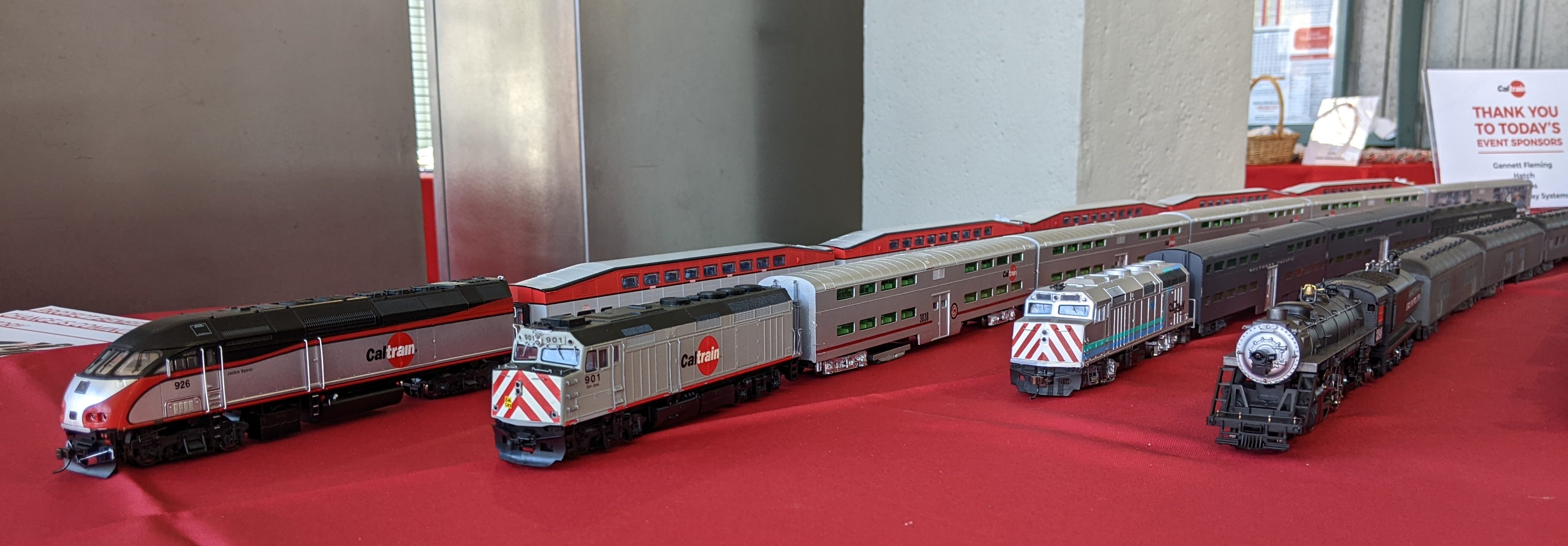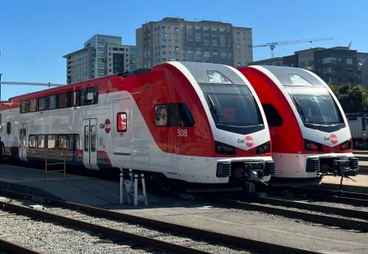Note: GJEL Accident Attorneys regularly sponsors coverage on Streetsblog San Francisco and Streetsblog California. Unless noted in the story, GJEL Accident Attorneys is not consulted for the content or editorial direction of the sponsored content.
Caltrain did a public unveiling of its first new electric train sets on Saturday at 4th and King Street Station in San Francisco. "This is our first taste of what the riders can expect," Michelle Bouchard, Executive Director of Caltrain, told Streetsblog during the event. Of course, the new cars are just the most visible piece of a $2.4 billion electrification project, which should be completed in 2024.
From a Caltrain release:
The new high-performance trains will offer a better service to Caltrain riders. They will generate much less noise than their diesel equivalent, making the trip more enjoyable both for riders and residents that live near Caltrain tracks. The new vehicles also offer enhanced amenities, including new digital onboard displays, power outlets at each forward-facing seat, a new seat color palette selected by the public, energy-efficient lighting, coat hooks, security cameras, and expanded storage under the cantilevered seats.
Additionally, each trainset will have seven cars, as opposed to the current five or six. The new trains also accelerate and decelerate faster than their diesel alternatives, which must be pulled by a locomotive. This will allow Caltrain to expand its service levels beyond the current 104 trains every weekday.
“The Bay Area is the high-tech capital of the world, and it deserves a transportation system that reflects that,” said Congresswoman Anna Eshoo, during a press conference held at the Caltrain depot on King Street. “The tracks that were laid in the time of the steam engine will carry modern, electric trains along the Peninsula, perfectly symbolizing our spirit of innovation and dynamic change.”
Unlike BART's "fleet of the future" modernization project, Caltrain is able to use standard, off-the-shelf rolling stock. The trains, while assembled in the U.S., are just a variant of the ubiquitous Stadler KISS from Switzerland. Stadler has sold over 1,000 such trains, which are capable of 110 mph, in countries throughout Europe (and Streetsblog has ridden them on several occasions). They run on standard-gauge tracks and use 25 kilovolts of electricity, which means in the future Caltrain will be able to swap equipment and do joint-orders with other American passenger railroads that use electric trains on the East Coast and in Chicago and Denver.
This use of standard equipment opens another possibility: Bouchard told Streetsblog that Caltrain is currently talking with Stadler about adding some hybrid trains to the order that can also run on batteries or hydrogen in addition to overhead electrification. That means some time after Caltrain electrification is completed between Tamien and San Francisco, it may become possible to run some non-diesel, one-seat services from San Francisco all the way to Gilroy. She even said there may eventually be Caltrain services as far south as Salinas. As reported, Caltrain's contract is for 96 train cars, with an option to purchase 20 more.
Meanwhile, cyclists got a look at Caltrain's new bike cars, which include several seats that will allow riders to keep an eye on their steeds. There are two bike cars per train, still fewer than hoped for by bike advocates and something that was a contentious issue when the cars were in development.
There will also be WiFi throughout and electrical outlets under every seat.
The trains' large bathrooms are fully compliant with the Americans with Disabilities Act and include baby changing stations.
Over the next couple of years Caltrain will be testing these trains and receiving more rolling stock until 75 percent of the existing, diesel-hauled fleet is retired (those old belching beasts will continue to operate on trains to and from Gilroy for a while). According to Caltrain, electrification of the 51 miles from San Francisco to Tamien will increase its capacity the equivalent of adding 5.5 new lanes to 101.

Caltrain will be doing more events to allow the public to tour the new trains. And soon enough, when all the wire is strung and tested, these new sets will be available to all who wish to ride them. Two more pictures below:






